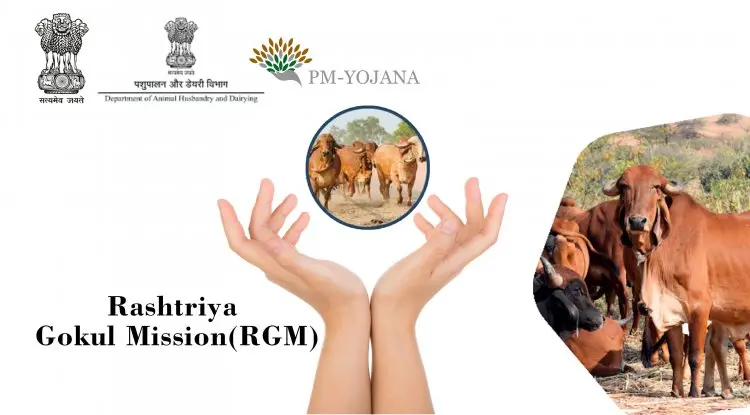Rashtriya Gokul Mission
The “Rashtriya Gokul Mission” has been launched by the Government for conservation and development of indigenous breeds in a focused and scientific manner.

Rashtriya Gokul Mission
The “Rashtriya Gokul Mission” has been launched by the Government for conservation and development of indigenous breeds in a focused and scientific manner.
Rashtriya Gokul Mission
Milk is an integral part of every household in India. People of every age group consume milk or milk products daily. Therefore, it is crucial that every person gets quality milk. Keeping this in mind, PM Narendra Modi, along with the Ministry of Agriculture & Farmer Welfare, announced the implementation of Rashtriya Gokul Mission in December 2014.
This initiative was implemented to conserve as well as develop the indigenous bovine breeds to scientifically improve the production as well as productivity of milk.
What is Rashtriya Gokul Mission?
Implemented under the National Programme for Bovine Breeding and Dairy Development (NPBBD), Rashtriya Gokul Mission aims to develop and conserve bovine breeds of India. It ensures enhanced productivity and production of milk in a scientific manner that includes improved nutrition as well as farm management.
This scheme helps to meet the growing demand for milk in the country. It also makes dairying more lucrative financially to the rural farmers.
The Rashtriya Gokul Mission scheme will continue from 2021 to 2026 under the umbrella scheme Rashtriya Pashudhan Vikas Yojna.
PM Narendra Modi along with the Ministry of Agriculture & Farmers Welfare announced the implementation of the Rashtriya Gokul Mission. This mission was launched under the National Programme for Bovine Breeding and Dairy Development during the 12th Five Year Plan.
What are the Objectives of Rashtriya Gokul Mission?
The Rashtriya Gokul Mission Ministry primarily focuses on these objectives –
- Development and conservation of the indigenous breeds.
- Distribution of disease-free bulls with high genetic merit for breeding purposes.
- Enhancing and increasing the productivity and production of milk.
- Upgrading of nondescript cattle using elite breeds like Sahiwal, Gir, Rathi, Deoni, Red Sindhi and Tharparkar.
- Optimising modern Farm Management practices and promoting Common Resource Management.
What are the Features of Rashtriya Gokul Mission?
Rashtriya Gokul Mission focuses on establishing integrated cattle development centres or Gokul Grams. These centres will be established in native breeding regions and near metropolitan cities to house the urban cattle.
Under Rashtriya Gokul Mission, the features of these Gokul Grams are as follows –
- They will be independent and will focus on generating economic resources. This will be done through the sale of organic manure, urine distillates, A2 milk and electricity production from biogas.
- These centres will act as local training centres for MAITRIs, farmers and breeders.
- Gokul Grams will provide farmers in the breeding business with high genetic breeding stock.
- These development centres maintain unproductive and milch animals in the ratio of 40:60. In addition, they can maintain around 1000 animals.
- In Gokul Grams, the house fodder production will provide the nutritional requirements of the animals.
What are the Benefits of Rashtriya Gokul Mission?
Benefits of Rashtriya Gokul Mission scheme are as follows –
- Enhanced milk production and productivity.
- Conservation and development of Indian breeds of milch cattle.
- Establishment of dairy infrastructure to improve processing, acquisition and marketing.
Women will also benefit from this scheme as more than 70% of the livestock work in this country is done by them.
How to Avail Benefits of Rashtriya Gokul Mission?
The State Implementing Agency (SIA) via Livestock Development Boards implements the RGM scheme. All agencies having a role in indigenous cattle development can avail of its benefits.
With the Rashtriya Gokul Mission, India hopes to see a better future for the cattle industry as well as the milk production industry.
Initiatives under Rashtriya Gokul Mission
Several initiatives were taken under the Rashtriya Gokul Mission for the conservation and development of the indigenous bovine breeds. Some of the major initiatives taken by the Government of India during the implementation of this mission are mentioned below:
- Various cattle development centres were established to develop indigenous breeds. These development centres were known as Gokul Grams.
- Initiating different awards for the farmers to encourage them to rear these indigenous breeds. Gopal Ratna award was given to the farmers for best management and maintenance of the Indigenous Breed while the Kamdhenu award was given for best managed Indigenous herd by Institutions/Trusts/ NGOs/ Gaushalas or best-managed Breeders’ societies.
- Establishment of National Kamdhenu Breeding Centre (NKBC) as a centre of excellence for the development and conservation of indigenous breeds in a scientific way.
- Developing an e-market portal for connecting the breeders and farmers. This e-market portal was named as ‘E-Pashu Haat – Nakul Prajnan Bazaar’.
- An animal wellness program, Pashu Sanjivani, was established that encompassed the provision of animal health cards.
- Use of advanced reproductive technology for a disease-free female bovine. This technology included In-vitro Fertilization (IVF) and Multiple Ovulation Embryo Transfer (MOET).
- Establishment of National Bovine Genomic Center for Indigenous Breeds (NBGC-IB).
PM recently inaugurated the following under Rashtriya Gokul Mission:
- Semen Station with state-of-the-art facilities in Purnea, Bihar.
- IVF lab established at Animal Sciences University, Patna.
- Sex sorted semen in artificial insemination by Baroni Milk Union in Begusarai district of Bihar.
What is a Gokul Gram?
India houses 14.5% of the world cattle population, out of which 83% of the population is indigenous. The Rashtriya Gokul Mission, which was implemented by the State Implementing Agency (SIA), focuses on the development of integrated indigenous cattle centres. These cattle centres are known as Gokul Grams.
A Gokul Gram mainly focuses on the following objectives:
- Promoting indigenous cattle rearing and their conservation in a scientific manner.
- Use of indigenous breeds for propagating high genetic merit bulls.
- Developing modern farm management practices, along with promoting common resource management.
- To utilize animal waste in an economical way.







